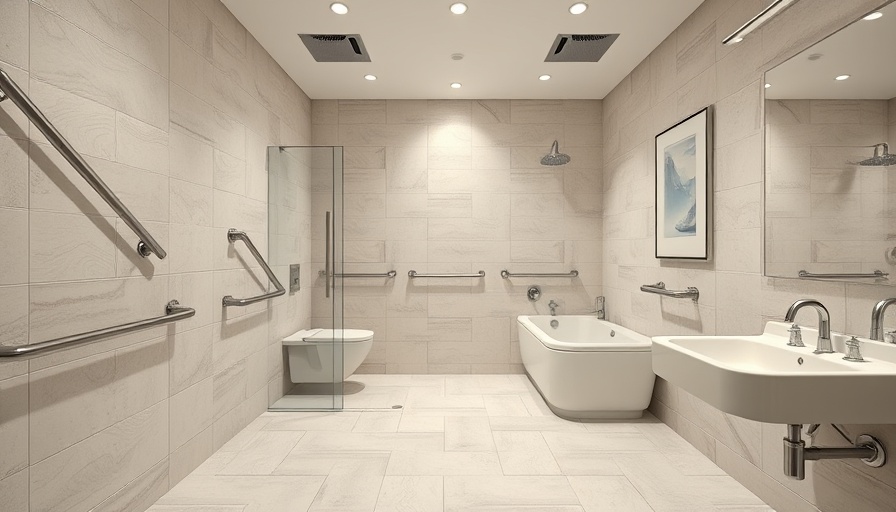
The Hidden Dangers: Recognizing Bathroom Hazards
Bathrooms, while often seen as tranquil sanctuaries, conceal significant risks that can lead to serious accidents, especially for vulnerable populations like the elderly and young children. Wet surfaces can create slippery conditions, and intricate layouts might confuse those with mobility challenges. Common incidents such as slips and falls frequently occur, often exacerbated by factors such as inadequate lighting and unfriendly design. For instance, misplaced towels and clutter can obstruct safety, while sharp edges on fixtures pose additional risks.
A vital first step in safeguarding your bathroom is conducting a comprehensive assessment. Identify hazards that may not be immediately apparent to all household members. What appears safe for younger adults might be perilous for a senior or a child requiring additional support. Building awareness about these risks is essential in creating a safer environment.
Essential Equipment for Enhanced Bathroom Safety
To mitigate risks, equipping your bathroom with the right safety gear is essential. Non-slip bath mats are indispensable; strategically placed around bathing areas, they provide the grip necessary to prevent falls. When selecting mats, look for those designed specifically for wet conditions to ensure effectiveness.
Moreover, grab bars, a simple yet powerful addition, significantly enhance safety. They can be installed next to toilets or inside showers, offering crucial support for individuals with limited mobility. The proper installation of these bars ensures they can safely bear weight. Furthermore, safety handles can assist with transfers in and out of bathtubs or onto toilets, extending independence for seniors.
Illuminating Safety: The Role of Lighting
Effective lighting is often overlooked but is paramount in ensuring bathroom safety. Poor visibility can lead to disorientation, increasing accident risk. Thus, bright, well-distributed light sources should be prioritized to illuminate all corners of the bathroom and minimize shadows.
Consider incorporating motion-sensor lights that activate upon entry, particularly in high-traffic areas. This feature is especially helpful for those who might need to navigate the bathroom at night. Adjustable brightness levels can cater to the varying needs and preferences of users, allowing for a bright lighting atmosphere during daily routines and a softer glow during a relaxing bath.
Designing with Family Needs in Mind
When creating or modifying a bathroom for safety, it’s crucial to consider the unique requirements of various family members. Children may need fixtures at a lower height, while seniors may benefit from barrier-free designs that accommodate walkers or wheelchairs.
Including features such as horizontal grab bars and lower storage solutions will allow children to access their bathing essentials safely and independently. Seniors, on the other hand, might require additional support like fold-down seats or non-slip surfaces that aid their mobility without compromising style.
Beyond the Essentials: Fostering Safe Habits
Safety extends beyond physical modifications; fostering mindful habits can further enhance bathroom safety. Encourage family members to develop routines that prioritize caution, such as drying floors after baths and organizing toiletries effectively to prevent clutter.
Creating a ‘safety first’ mindset will cultivate an atmosphere where all members of your household feel secure while using the bathroom and are more adept at recognizing hazards.
Tools and Resources for Continued Learning
To ensure sustained safety in the bathroom, leverage available resources to stay informed about the latest safety techniques and innovative tools designed for home use. Expert insights into products and design updates can dramatically improve your home’s safety profile.
Consider subscribing to publications focused on home safety or contacting experts, such as occupational therapists, who specialize in safe home environments. Utilizing community resources can also provide valuable feedback on home modifications that work well for families similar to yours.
Taking Action: Transform Your Bathroom Today
Implementing the above recommendations can profoundly affect your household's safety and comfort. Prioritizing bathroom safety is not just a task; it’s a commitment to creating a nurturing environment for everyone—particularly those who are the most vulnerable in your family. Engage with experts, consider your unique needs, and be proactive in making your bathroom a refuge rather than a risk.
Embrace these insights and take the first steps toward a safer bathroom today!
 Add Row
Add Row  Add
Add 




 Add Row
Add Row  Add
Add 

Write A Comment